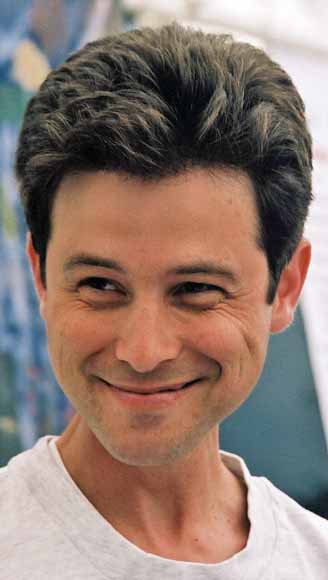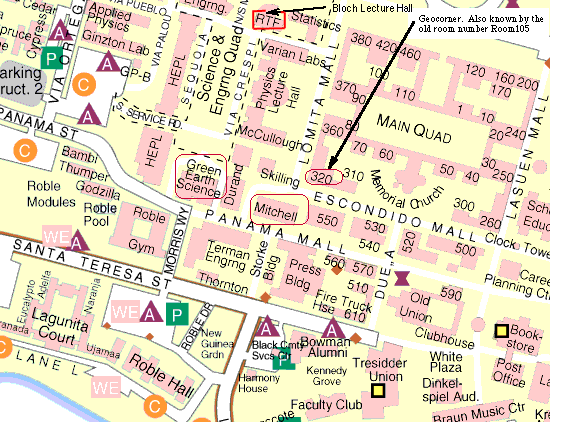
Location: Stanford University
see Map showing Mitchell and GeoCorner Room 320
This will be the 389th meeting since 1954

Map of Yellowstone National Park and vicinity. Thick black line is the boundary of the Yellowstone Caldera. Thin black lines are roads. Gray outline is park boundary. Red regions are thermal areas. Dashed line shows state boundaries (from USGS SIR-2006-5276).
The Yellowstone caldera is well known for its cycles of uplift and subsidence over both historic and geologic timescales. Most models for deformation assume sources due to transport of magma or hydrothermal brine streaming through ruptured permeability barriers. Recent investigations of chemical mass balance at Yellowstone provide critical insights into potential sources of both deformation and heat. Volatile fluxes from the Yellowstone caldera have been calculated by summing the flux of Cl–, F, SO42–‚ and HCO3– through the major rivers leaving the Yellowstone Plateau. Long-term studies show that Cl–, the primary non-H2O component of geothermal brines has not changed appreciably in output during recent periods of subsidence and uplift. Instead, Cl– flux is dominated by recharge constraints, increasing during periods of greater precipitation. Carbon is much more abundant than sulfur in Yellowstone’s waters, but is even more dominant when combined with data on gas flux from fumaroles and diffuse degassing. In fact, CO2 is about 300 times more abundant than Cl– on a molar basis as an effluent from the Yellowstone hydrothermal system. Similarly sulfur flux exceeds Cl– by about 25 times what one would expect from the concentrations in degassed volcanic rocks that could be leached. Phase equilibrium constraints imply that the shallow subsurface at Yellowstone (the upper two km) should be saturated with a CO2-rich vapor phase under most conceivable P-T conditions. This volumetrically significant (even dominant) phase should have an important role in pressurization of the hydrothermal system and may contribute to ongoing cycles of deformation within the caldera. The volatile “signature” from Yellowstone strongly suggests that gas discharge is controlled not by the crustal granitic magma chamber but by subjacent basaltic intrusions that provide both heat and mass to the overlying system

Jake Lowenstern
Reservations: The preferred way to make reservations is simply to email Janice Sellers at janicemsj@gmail.com by May 4, tell her you will attend, commit to pay, and bring your payment to the meeting. Janice always emails a confirmation; if you don’t get one, assume email crashed yet again and email her a second time. A check made to "PGS" is preferred, payable at the meeting.
If you want to pay in advance:
Stanford faculty and students: Please make dinner reservations by May 4. Contact Dr. Elizabeth Miller via her mailbox (and leave check), Geological and Environmental Sciences Office, Geocorner - Bldg. 320 (Rm. 205). Make checks out to "PGS."
All others, including faculty and students from other Bay Area universities and colleges and USGS: Please make dinner reservations by April 6. Contact Janice Sellers, at 1066 28th Street, Oakland, CA 94608-4547, (510) 268-8254. Send check made out to "PGS" to Janice.
Dinner is $30.00. Includes wine (5:30 to 6:15 PM.) and dinner (6:15-7:30 PM.).
For students from all universities and colleges, the dinner, including the social 3/4-hour, is $5.00 and is partially subsidized thanks to the School of Earth Sciences, Stanford University (Note, no-show reservations owe the full price).
Doris, whose wonderful crew prepares our meals, asked that we let you know that people who are late RSVP’ing and people who show up without a reservation will be welcome but that they will be eating on paper plates with plastic utensils (food supply permitting).
Dues for Academic Year 2006-2007 ($10.00) should be sent to Janice Sellers, 1066 28th Street, Oakland, CA 94608-4547. Janice’s phone: (510) 268-8254.
Officers: Ray Wells, President; Dwight Harbaugh and Elizabeth Miller, Co-Vice Presidents; Mike Diggles, Secretary; Janice Sellers, Treasurer; Bob Coleman, Field-Trip Czar

Date created: April 27, 2007
Last modified: April 27, 2007
Created by: Mike Diggles, Webmaster-Secretary, PGS.